iran
Worn on its Sleeve
The chattering classes are aflutter that the President of Iran yesterday called Israel “a cruel and repressive racist regime” at the UN Conference on Racism. 23 diplomats stormed out, others applauded. While Ahmadinejad has said some pretty outrageous things, in this case I wonder if he saw this latest item in the Israeli daily Haaretz about T-shirt designs Israeli soldiers are ordering for their IDF units. The shirts boast slogans and images of dead Palestinian babies, bombed mosques, jokes about rape, sniping children, killing pregnant women in Hijab, etc. The designs are revealing. This is clearly not a military culture solely preoccupied with defending the integrity of the State.
Sloganeering
A year ago, I received an email from “Tony:”
“I have looked all over the web, and just can’t find the simple themes that can be posted to the back of poster board or foam board and used at street vigils. I just need simple stuff for 11 by 17 AND 8 1/2 BY 11 COPYING.
Can you help? The power of one or two people in public holding simple antiwar protest messages is great. I just can’t find anything on the net that isn’t too artsy-fartsy, or too damn pacifist-wimpy.”
I smacked into this “artsy-fartsy” factor again a few weeks ago when United for Peace and Justice asked if I could turn out some poster designs on short notice. They sent their final copy and I set to thinking about how to represent things iconographically in a beautiful, compelling way. I rummaged through the usual toolbox (coffins, dollars, boots, ribbons, etc.) as well as play with color and typographic notes (big X’s, oversized punctuation, etc.) One slogan in particular raised an interesting problem: how to graphically represent “community” for marches in eleven very different cities.
Nevertheless, over the weekend’s iteration the org requested the gradual removal of all imagery, iconography, and embellishment. I was trying to do something graphically interesting to myself, but the group had a very specific use case in mind. The posters were not intended for pasting on the street, to attract passersby with flourish, humor, or imagery. They wanted something to be carried high and read from a distance, particularly when reproduced in photos, newspaper clippings, or seconds-long TV news highlights. As such, these were props to represent the march in memory as much as in person, to disappear and punch the message through network editing and newspaper cropping. The simpler and bolder the better.
With a little more time I would have refined these further, but here are the results below. Click on a thumbnail to download a printable PDF.
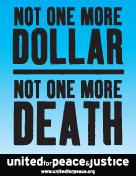
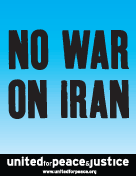

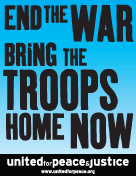

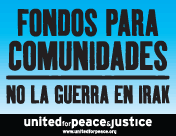
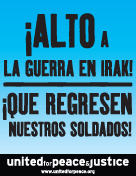
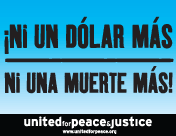
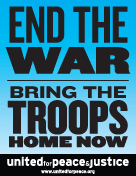
Shoots & Leaves
While one may be tempted to use all manner of exclamatory marks to further amplify the message of one's posters, proper punctuation almost always enhances clarity. Consider the difference in the following:
No War on Iran!
Versus
No! War on Iran!
Or even
No! War! On Iran!

Puppet Regime
 UNICEF has a brief publication online discussing puppetry as a medium for education and social change. It quotes practitioners in Indonesia, South Africa, Iran, and Hong Kong. Another twenty or so examples from around the world, primarily focusing on public health, are listed here. (via)
UNICEF has a brief publication online discussing puppetry as a medium for education and social change. It quotes practitioners in Indonesia, South Africa, Iran, and Hong Kong. Another twenty or so examples from around the world, primarily focusing on public health, are listed here. (via)
See also this brief history of radical puppetry in the U.S. and Europe.
Banned in Translation
From Democracy Now!:
“The U.S. Treasury Department’s Office of Foreign Assets Control recently declared that American publishers cannot edit works authored in nations under trade embargoes which include Iran, Iraq, Sudan, Libya and Cuba.
Although publishing the articles is legal, editing is a ‘service’ and the treasury department says it is illegal to perform services for embargoed nations. It can be punishable by fines of up to a half-million dollars or jail terms as long as 10 years.
Robert Bovenschulte, president of the publications division of the American Chemical Society, which decided this week decided to challenge the government and risk criminal prosecution by editing articles submitted from the five embargoed nations.”
From the Treasury Department itself:
“As you know, the importation from any country and the exportation to any country of information and informational materials, whether commercial or otherwise, regardless of format or medium of transmission, are exempt from the Iranian Transactions Regulations, 31 C.F.R. Part 560 (the ITR). ITR, § 560.210(c)....
Nevertheless, certain activities described in your letter would fall outside of the information and informational materials exemption. The collaboration on and editing of manuscripts submitted by persons in Iran, including activities such as the reordering of paragraphs or sentences, correction of syntax, grammar, and replacement of inappropriate words by U.S. persons, prior to publication, may result in a substantively altered or enhanced product, and is therefore prohibited under ITR § 560.204 unless specifically licensed.”
Boy is this ever crying out for civil disobedience from all of us bloggers. I’m not sure if republishing or translating information off the Web is covered by this (since it’s accessible anyway), but posting translations of otherwise published or unpublished material probably would be.
Let the Office of Foreign Assets Control know about it at ofac_feedback@do.treas.gov. To complain to the Department of Justice about the issue email AskDOJ@usdoj.gov.
Via the Project Censored and Juan Cole
Whether
Why the urgent rush to war RIGHT NOW?
The longer the delay, the greater the risk of U.S. casualties.
From NBC 10:
“If Iraq is to be invaded, the greater the delay, the greater the potential problems. Temperatures that average 80 on April 1, rise to 110 in June, with some days as hot as 120.”
“A typical American soldier goes into combat with a heavy load, so if you send your troops into the Middle East during the warm part of the year, you are risking problems from heat stroke, sunstroke and all kinds of elements,” said Gregory Urwin of Temple University.
“The problem in fall is the combination of dry air and strong winds, which creates bad dust or sandstorms,” Schwartz said.
“It was a dust storm that brought down a helicopter that was part of the attempt to rescue the hostages in Iran.
“Weather and moon conditions are ideal right now. There is also something called moonrise and moonset. Even next week, there will be four to six hours of total darkness each night. The modern military may be less-dependant on moon phases than in the past, but if they wait too long, potential problems increase and ideal weather is unlikely until next winter.”
If the invasion is delayed just a few more weeks, perhaps it won’t actually happen...
Underexposed
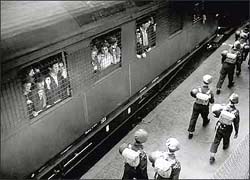 The people in the black and white photo behind the bars of the boxcar in the 1940’s German train station are not Jews off to the camps to be killed. They are indeed German Jews off to a camp, but the photo was taken after the end of war, the soldiers on the platform are British, and the passengers are survivors of Nazi concentration camps, denied entry into Palestine. Here, they are being transported from Hamburg docks to the Poppendorf detention camp.
The people in the black and white photo behind the bars of the boxcar in the 1940’s German train station are not Jews off to the camps to be killed. They are indeed German Jews off to a camp, but the photo was taken after the end of war, the soldiers on the platform are British, and the passengers are survivors of Nazi concentration camps, denied entry into Palestine. Here, they are being transported from Hamburg docks to the Poppendorf detention camp.
The photo and its story are reproduced in Underexposed. From Vision On Publishing:
“Underexposed tells the stories behind the photographs which determine our view of history, providing a reality check on alleged events from the last hundred years and documenting the struggle of the powerful to contend with rival cultural forces of media and information. Reclaimed from the trash cans of the Second World War. From the cruelty of Stalin’s Russia and fundamentalist chaos in Iran to the horrors of the Gulf war and perspectives on September 11th — even Hitler’s preening speech rehearsals come back to argue with his self-made myth. Via disgruntled starlets, ecological destruction and US nuclear tests, Underexposed gathers together some of the most ideologically dangerous photographs ever taken and releases them to haunt the increasingly manipulated, re-touched present.”
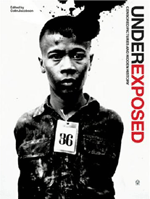 I found the book on the front table at St. Mark’s Books, mixed with the latest compilations on cyber-typography, club flyers, erotica, and graphic novels. The juxtaposition is continued on the publisher’s Web site. Among the publisher’s list of glossy photo books of rock stars, fashion, erotica, and a celebration of the Manchester City Football Club (and its fans), Underexposed seems a bit like war porn. The design of the book is certainly less than sober, full of dramatic, oversized, full-bleed spreads and a hip sans serif typeface. Each photo is provided with some background, but the captions only allow so much space.
I found the book on the front table at St. Mark’s Books, mixed with the latest compilations on cyber-typography, club flyers, erotica, and graphic novels. The juxtaposition is continued on the publisher’s Web site. Among the publisher’s list of glossy photo books of rock stars, fashion, erotica, and a celebration of the Manchester City Football Club (and its fans), Underexposed seems a bit like war porn. The design of the book is certainly less than sober, full of dramatic, oversized, full-bleed spreads and a hip sans serif typeface. Each photo is provided with some background, but the captions only allow so much space.
The bottom line: photographs can lie. Particularly those that purport to be objective. Taken out of context, they are cropped, altered, and framed by the context at hand and by cultural assumptions. And page after page, the flouting of taboo and power starts to flatten out. Like all the speakers in the corner of Hyde Park, all ideologies become equivalent.
That said, the book does rouse a healthy dose of skepticism. It also crosses into the terrain of Barthes’s Mythologies, an examination of connections between language, imagery, ideology, and power and a wandering interrogation of “the obvious.”
From a review in The Guardian:
“In one of the most shocking images, taken from the Sudanese famine of 1984, Wendy Wallace photographed the photographers at work snapping an emaciated child who had been brought out to sit in the dirt precisely for that image.
It is a theme that recurs in Alex Webb’s pictures of the American invasion of Haiti. A line of US troops lies dramatically - heroically - on the Tarmac at Port au Prince airport aiming their weapons at an unseen enemy. Most media organisations showed this image. Webb’s version shows the reality: the only figures are half a dozen and more photographers and cameramen crouched in front of the soldiers, puncturing the dramatic image in a campaign that was to see virtually no opposition to US troops.”
See an excerpt from the forward to the book, some photos from the book, or listen to an audio interview with Colin Jacobson, former photo editor for a number of British news magazines and editor of Underexposed.
...
Also of note, The Commissar Vanishes: The Falsification of Photographs in Stalin’s Russia, an small online exhibit of doctored photos and propaganda posted by the Newseum. Shown here, Stalin with Nikolai Yezhov, commissar of water transport, before and after he was purged.
Images from the Iranian Revolution
NYU’s Grey Art Gallery is showing some of its photos and posters from the Iranian Revolution in Between Word and Image: Modern Iranian Visual Culture.
“While the posters were produced by a wide range of political groups, most make direct appeals to action by defying power, subverting authority, and inverting icons as a means to authorize oppositional ways of thinking and behavior....
As social discontent increased throughout the 1970s, some of Iran’s leading contemporary artists assumed an active role in the production of political posters. Inspired by the French student movement of 1968, a group of Iranian artists opened a workshop at the University of Tehran in 1978. The workshop provided the materials and equipment for printing posters to members of various political groups. Professional artists worked alongside amateurs. Their results were displayed throughout Tehran — in schools, in factories, and on the walls of other buildings, often defacing public monuments built by the Pahlavi regime as symbols of its authority and grandeur. As government agents tore them down or covered them with paint, protesters would replace them with replenished supplies.”
The show juxtaposes some modern painting and sculpture from Iran in the 1960s and ’70s.
See other photos, murals and posters from Staging Revolution: The Art of Persuasion in the Islamic Republic of Iran. (Annotation but no thumbnails at the last link, just keep clicking ‘next image.’)
More posters (with a nice thumbnail index) at islamicdigest.net.
Grey link found via American Samizdat.
Women in Iran Battle Taboo with Blog
“The web is providing a way for women in Iran to talk freely about taboo subjects such as sex and boyfriends. Over the past few months there has been a big jump in the number of Persian weblogs which are providing an insight into a closed society.... ‘I could talk very freely and very frankly about things I could never talk about in any other place, about subjects that are banned,’ said one of the first women to start a blog in Iran.”
From BBC News.
page 2 1




